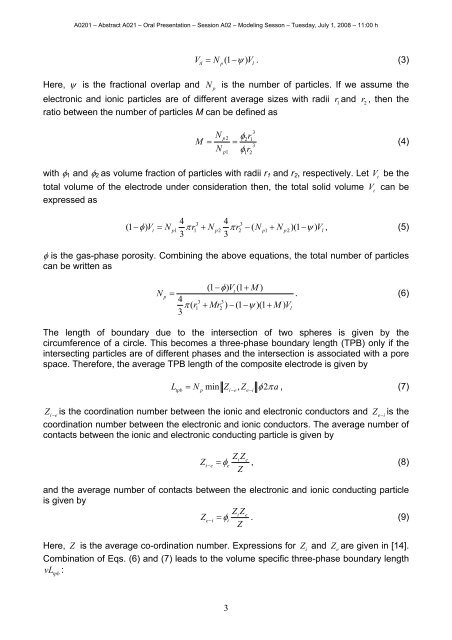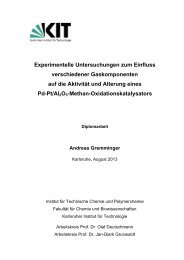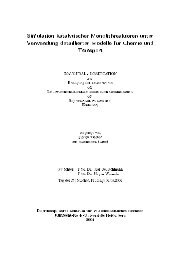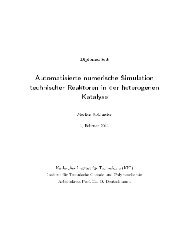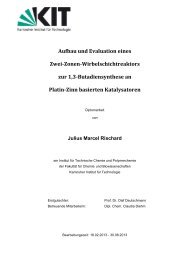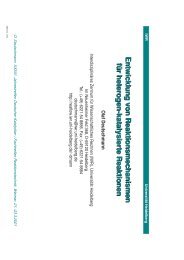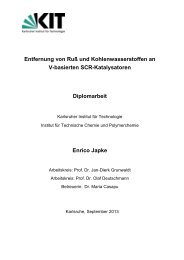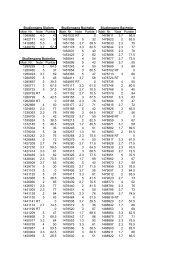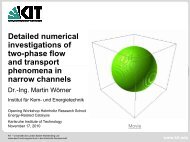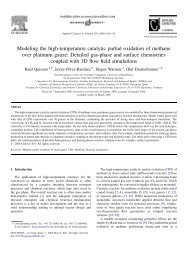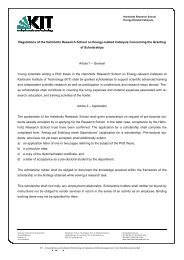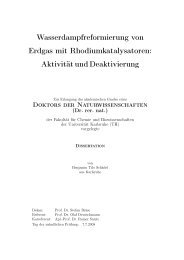SOFC Modeling - From Micro-Kinetics to Stacks - KIT
SOFC Modeling - From Micro-Kinetics to Stacks - KIT
SOFC Modeling - From Micro-Kinetics to Stacks - KIT
Create successful ePaper yourself
Turn your PDF publications into a flip-book with our unique Google optimized e-Paper software.
A0201 – Abstract A021 – Oral Presentation – Session A02 – <strong>Modeling</strong> Sesson – Tuesday, July 1, 2008 – 11:00 h<br />
V = N (1 − ψ ) V . (3)<br />
tl p l<br />
Here, ψ is the fractional overlap and N<br />
p<br />
is the number of particles. If we assume the<br />
electronic and ionic particles are of different average sizes with radii r 1<br />
and r<br />
2<br />
, then the<br />
ratio between the number of particles M can be defined as<br />
M<br />
N<br />
3<br />
p2<br />
φ2r1<br />
= =<br />
(4)<br />
3<br />
N<br />
p1<br />
φ1r2<br />
with φ 1 and φ 2 as volume fraction of particles with radii r 1 and r 2 , respectively. Let V<br />
t<br />
be the<br />
<strong>to</strong>tal volume of the electrode under consideration then, the <strong>to</strong>tal solid volume V t<br />
can be<br />
expressed as<br />
4 3 4 3<br />
(1 − φ) Vt = Np 1<br />
πr1 + Np2 πr2 − ( Np 1+ Np2)(1 − ψ)<br />
Vl, (5)<br />
3 3<br />
φ is the gas-phase porosity. Combining the above equations, the <strong>to</strong>tal number of particles<br />
can be written as<br />
N<br />
p<br />
=<br />
(1 − φ) Vt<br />
(1 + M)<br />
4 (<br />
3 3<br />
π r1 + Mr2<br />
) − (1 − ψ )(1 + M ) Vl<br />
3<br />
. (6)<br />
The length of boundary due <strong>to</strong> the intersection of two spheres is given by the<br />
circumference of a circle. This becomes a three-phase boundary length (TPB) only if the<br />
intersecting particles are of different phases and the intersection is associated with a pore<br />
space. Therefore, the average TPB length of the composite electrode is given by<br />
L = N min Z , Z φ2π<br />
a, (7)<br />
tpb p i−e e−i<br />
Zi − eis the coordination number between the ionic and electronic conduc<strong>to</strong>rs and Ze − iis the<br />
coordination number between the electronic and ionic conduc<strong>to</strong>rs. The average number of<br />
contacts between the ionic and electronic conducting particle is given by<br />
Z<br />
Z Z<br />
Z<br />
= i e<br />
i− e<br />
φ , (8)<br />
e<br />
and the average number of contacts between the electronic and ionic conducting particle<br />
is given by<br />
ZiZe<br />
Z = e− i<br />
φi<br />
Z<br />
. (9)<br />
Here, Z is the average co-ordination number. Expressions for Z<br />
i<br />
and Ze<br />
are given in [14].<br />
Combination of Eqs. (6) and (7) leads <strong>to</strong> the volume specific three-phase boundary length<br />
vL :<br />
tpb<br />
3


